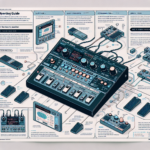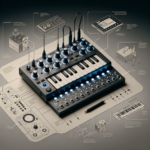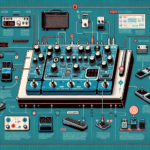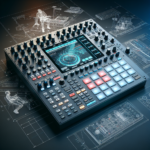Roland FC-300: Comprehensive Guide to Features, Setup, and Performance

Introduction
The Roland FC-300 is a versatile MIDI foot controller designed to provide musicians with hands-free control over their MIDI-compatible equipment. Whether you’re a guitarist looking to control effects pedals, a keyboardist seeking to manage multiple sound modules, or a producer aiming to streamline your workflow, the FC-300 offers a robust solution. Targeted at both amateur and professional musicians, this controller is known for its reliability and extensive feature set.
Roland, a brand synonymous with innovation in the music industry, has a long-standing reputation for producing high-quality musical instruments and accessories. The FC-300 is no exception, embodying the brand’s commitment to excellence.
Key Features Overview:
- Dual Expression Pedals
- 10 Footswitches
- RRC2 and MIDI Connectivity
- Patch Memory
- Robust Build Quality
- Customizable MIDI Mapping
Design and Build Quality
Physical Design
The Roland FC-300 boasts a rugged and professional design. Measuring approximately 22.5 inches in width, 8.5 inches in depth, and 3.5 inches in height, it is compact enough to fit into most pedalboards. Weighing around 10 pounds, it strikes a balance between sturdiness and portability. The unit is constructed from high-quality metal and durable plastic, ensuring it can withstand the rigors of live performances and studio use.
Portability
Despite its robust build, the FC-300 is relatively easy to transport. Its compact size allows it to fit comfortably in most gig bags or pedalboard cases, making it a convenient choice for musicians on the go. The weight is manageable, ensuring that it won’t be a burden during transportation.
Durability
Roland has a reputation for producing durable equipment, and the FC-300 is no exception. The metal chassis and high-quality components ensure that the controller can endure regular use without significant wear and tear. The footswitches and expression pedals are designed to be responsive and long-lasting, providing reliable performance over time.
Setup and Configuration
Initial Setup
Setting up the Roland FC-300 is straightforward. Follow these steps to get started:
- Unbox the FC-300 and connect the power adapter.
- Connect the FC-300 to your computer or MIDI-compatible hardware using the appropriate cables (MIDI or RRC2).
- Power on the FC-300 and your connected devices.
- Use the onboard display and navigation buttons to configure the initial settings, such as MIDI channels and control assignments.
Software Installation
While the FC-300 does not require specific drivers, you may need to install MIDI interface drivers if you are connecting it to a computer. These drivers are usually available on the manufacturer’s website. Additionally, some DAWs may require specific configurations to recognize the FC-300 as a MIDI controller.
Compatibility
The Roland FC-300 is compatible with a wide range of operating systems and software:
- Operating Systems: Windows, macOS
- DAWs: Ableton Live, FL Studio, Logic Pro, Cubase, Pro Tools, and more
- Other Software: Any MIDI-compatible software or hardware
Features and Functionality
Key Features
The FC-300 is packed with features designed to enhance your musical performance:
- Dual Expression Pedals: These pedals allow for real-time control over parameters such as volume, wah, or any other assignable function.
- 10 Footswitches: These switches can be assigned to various functions, such as patch changes, effect toggles, or MIDI commands.
- RRC2 and MIDI Connectivity: The FC-300 can connect to other Roland devices via RRC2 or to any MIDI-compatible device, offering versatile connectivity options.
- Patch Memory: Store and recall up to 100 different patches, each with its own unique settings.
Customizability
The FC-300 offers extensive customization options. Users can assign different MIDI messages to each footswitch and expression pedal, allowing for a highly personalized setup. The onboard display and navigation buttons make it easy to configure these settings without the need for additional software.
Unique Functions
One of the standout features of the FC-300 is its ability to operate in different modes, such as Standard Mode and Control Mode. Standard Mode allows for traditional patch changes and control assignments, while Control Mode offers more advanced MIDI control options, making it a versatile tool for various applications.
Integration with DAWs
The FC-300 integrates seamlessly with popular DAWs. For example, in Ableton Live, you can map the footswitches and expression pedals to control various parameters, such as track volume, effects, and transport controls. Similarly, in Logic Pro, you can use the FC-300 to switch between different patches and control software instruments.
Advanced Features
The FC-300 includes several advanced features that enhance its functionality:
- Aftertouch: Provides additional expression by responding to the pressure applied to the footswitches.
- Arpeggiators: While not a built-in feature, the FC-300 can control external arpeggiators via MIDI.
- Chord Modes: Assign footswitches to trigger specific chords, making it easier to play complex harmonies.
Performance
Latency and Responsiveness
The FC-300 is known for its low latency and high responsiveness. The footswitches and expression pedals respond quickly to user input, ensuring that there is no noticeable delay during performances. This makes it an excellent choice for live settings where timing is crucial.
Real-World Usage
In practical scenarios, the FC-300 performs exceptionally well. Whether you’re using it to control effects pedals during a live performance or managing multiple sound modules in a studio session, the controller offers reliable and consistent performance. Its robust build quality ensures that it can withstand the demands of regular use.
User Experience
Users generally have positive feedback about the FC-300. Many appreciate its versatility and ease of use, noting that it significantly enhances their workflow. The customizable features and robust build quality are frequently highlighted as standout aspects of the controller.
Applications and Use Cases
Beginner vs. Professional Use
The FC-300 is suitable for both beginners and professionals. Its intuitive design makes it accessible for newcomers, while its extensive feature set provides advanced users with the tools they need for complex setups.
Studio Use
In a studio environment, the FC-300 excels in controlling multiple MIDI devices and software instruments. Its patch memory feature allows for quick recall of different setups, making it a valuable tool for music production and recording.
Live Performance
The FC-300 is particularly well-suited for live performances. Its robust build quality ensures it can withstand the rigors of touring, while its low latency and high responsiveness make it a reliable choice for real-time control over effects and instruments.
Specific Genres
The FC-300 is versatile enough to be used across various genres of music. However, it particularly excels in genres that require extensive use of MIDI control, such as EDM, hip-hop, and progressive rock. Its ability to control multiple parameters simultaneously makes it a valuable tool for these styles of music.
Pros and Cons
Pros:
- Robust build quality
- Extensive customization options
- Low latency and high responsiveness
- Versatile connectivity options
- Suitable for both beginners and professionals
Cons:
- Relatively heavy for a foot controller
- Initial setup can be complex for beginners
- Limited onboard display size
Common Issues and Troubleshooting
Known Issues
Some users have reported issues with the expression pedals becoming less responsive over time. Additionally, there have been occasional reports of connectivity issues with certain DAWs.
Troubleshooting Tips
- If the expression pedals become less responsive, try recalibrating them using the onboard settings.
- For connectivity issues, ensure that you have the latest drivers installed and that your DAW is configured correctly to recognize the FC-300.
Customer Support
Roland is known for its excellent customer support. Users can access a range of resources, including user manuals, FAQs, and video tutorials, on the Roland website. Additionally, the company offers responsive customer service through email and phone support.
Comparisons with Similar Controllers
Competitor Comparison
When compared to similar models from other brands, such as the Behringer FCB1010 and the Line 6 FBV 3, the Roland FC-300 stands out for its build quality and extensive feature set. While the Behringer FCB1010 offers similar functionality at a lower price point, it lacks the robust construction and advanced features of the FC-300. The Line 6 FBV 3, on the other hand, offers a more modern design but is less versatile in terms of MIDI control.
Feature Comparison
The FC-300 excels in areas such as build quality, customizability, and advanced features. While it may be heavier and more complex to set up than some competitors, its extensive feature set and reliable performance make it a superior choice for serious musicians.
Conclusion
Summary
The Roland FC-300 is a versatile and reliable MIDI foot controller that offers extensive customization options and robust build quality. Its low latency and high responsiveness make it an excellent choice for both studio and live performance settings.
Who Should Buy This?
The FC-300 is ideal for musicians who require hands-free control over their MIDI-compatible equipment. Whether you’re a guitarist, keyboardist, or producer, this controller offers the features and reliability you need to enhance your performance.
Final Thoughts
Overall, the Roland FC-300 is a top-tier MIDI foot controller that lives up to the brand’s reputation for quality and innovation. While it may have a few minor drawbacks, its extensive feature set and reliable performance make it a worthwhile investment for any serious musician.
FAQ
Is the Roland FC-300 compatible with all DAWs?
While the FC-300 is compatible with most popular DAWs, some may require specific configurations or drivers to recognize the controller.
Can I use the FC-300 to control multiple devices simultaneously?
Yes, the FC-300 can control multiple MIDI-compatible devices simultaneously, making it a versatile tool for complex setups.
How do I update the firmware on the FC-300?
Firmware updates can be downloaded from the Roland website and installed via MIDI or USB connection.
What is the warranty period for the Roland FC-300?
The FC-300 typically comes with a one-year warranty, but this may vary depending on the region and retailer.
Where to Buy
The Roland FC-300 can be purchased from various music equipment retailers, both online and in physical stores. Some of the well-known retailers include Guitar Center, Sweetwater, and Sam Ash. Additionally, it is available on major e-commerce platforms such as Amazon and eBay.




